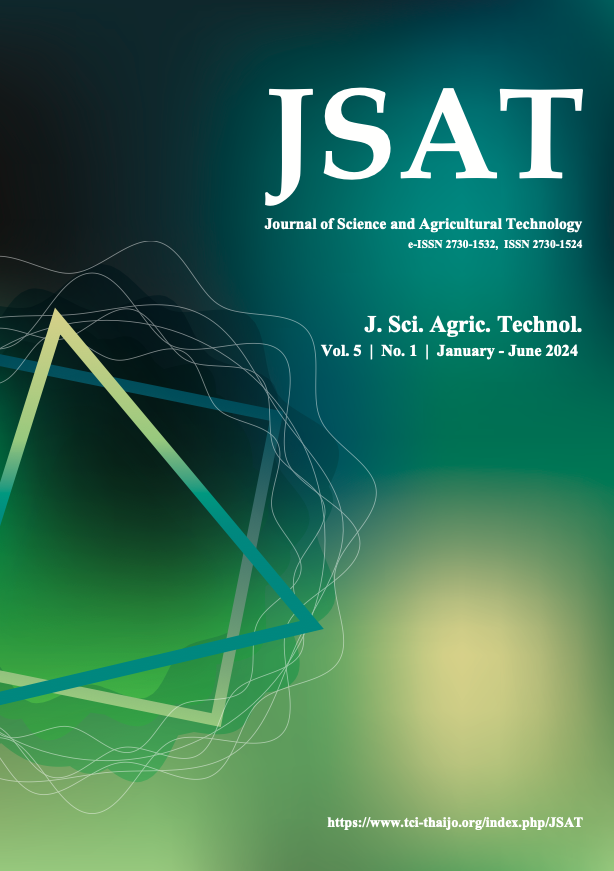Detecting the antifungal activity of the piper genus against Colletotrichum capsici, the cause of chili anthracnose
Main Article Content
Abstract
Article Details

This work is licensed under a Creative Commons Attribution-NonCommercial-NoDerivatives 4.0 International License.
References
Atefeh, S., Farhana, Y., Mohammad, F.F.K., Zarizal, S., Mohd, N.M.D., Hussain, M.K., Muhammad, N.S., Corazon, A.F., Lay, K.T., Mohd, Z.S., and Zainul, A.Z. 2013. Review on the ethnomedicinal, phytochemical and pharmacological properties of Piper sarmentosum: scientific justification of its traditional use. Tang. Hum. Med. 3(3): 19.1-19.32.
Azelan, A., Taher, Z.M., Sasano, S., Ariga, T., and Aziz, A.A. 2020. Chemical constituents and bioactivity of Piper sarmentosum: a mini review. Food. Res. 4(Suppl. 2): 14-18.
Biswajit, P., Mihir, T.D., and Surjendu, K.D. 2016. A review on Piper betle L. J. Med. Plant. Stud. 4(6): 185-192.
Chatsuda, P., Chisanuphong, P., and On-Uma, R. 2021. Evaluation of certain fungicide resistance of Colletrichum ssp., causal agent of disease in chilli. Khon. Kaen. Agri. J. Suppl. 1: 801-807.
Depi, S., Rusdi., and Sestry, M. 2020. Review of traditional use, phytochemical and pharmacological activity of Piper betle L. Gal. Int. J. Health. Sci. Res. 5(3): 59-66.
Food and Agriculture Organization of the United Nations (FAO). 2020. World Food and Agriculture - Statistical Yearbook 2020, Rome. from https://doi.org/10.4060/cb1329en.
Intzar, A., Farrah, G.K., Krishan, A.S., Bishan, D.G., Naresh, K.S., Prabhu, D., and Farhat, A. 2010. In vitro antifungal activity of hydroxychavicol isolated from Piper betle L. Annal. Clinic. Micro. Anti. 9(7): 1-9.
Krishna, T., Yashwanti, K., Surenda, U., Ateet, S., and Kumar, K.M. 2019. Piperine production from endophytic fungi of Piper nigrum l and it’s In Silico approach for anti-inflammatory and anti-mycobacterial potential. Int. Res. J. Bio. Sci. 8(12): 8-15.
Kushagra, N., Mukesh, K.S., Amit, A., Tekeshwar, K., Dhansay, D., Hemant, B., and Tripathi, D.K. 2011. Piper betle L.: A review on its ethnobotany, phytochemistry, pharmacological profile and profiling by new hyphenated technique DART-MS (Direct Analysis in Real Time Mass Spectrometry). J. Pharm. Res. 4(9): 2991-2997.
Lucy, J., Umi, K.Y., and Nulit, R. 2011. Antifugal activity of selected plant leaves crude extracts against a pepper anthracnose fungus, Colletotrichum capsica (Sydow) butler and bisby (Ascomycota: Phyllachorales), African. J. Biotech. 10(20): 4157-4165.
Maizatul, A.I., and Aiesyaa, M.E. 2020. Anti-fungal study on aqueous and ethanolic leaves extracts of Piper sarmentosum. Mat. Sci. Pharma. 4(1): 13-17.
Manju, B., Surbhi, G., and Narayan, L.M. 2020. A review: chilli anthracnose, its spread and management. J. Pharma. Phyto. 9(4): 1432-1438.
May, M.O., and Sang, K.O. 2016. Chilli anthracnose (Colletotrichum spp.) disease and its management approach. Korean. J. Agri. Sci. 43(2): 153-162.
Meghana, S.N., and Hiremath, S.V. 2019. Cultural, morphological and molecular characterization of Bipolaris oryzae causing brown leaf spot of rice in northern Karnataka. J. Pharma. Phyto. 8(2): 1235-1239.
Mohib, K., and Mustafa, S. 2007. Antimicrobial activity of piper fruits. Nat. Prod. Rad. 6(2): 111-113.
Mohd, S.A., Guteta, B., and Shiferaw, D. 2014. Antimicrobial activity of Piper nigrum L. and Cassia didymobotyra L. leaf extract on selected food borne pathogens. Asian. Pac. J. Trop. Dis. 4(Suppl 2): S911-S919.
Nicephore, M.C., Agossou, P.N., Brice, A.M.O., Noel, S.T., Fation, T., Lamine, B.M., Aly, S., and Farid, B.M. 2021. Chilli pepper (Capsicum Spp.) diversity, production and fungal contamination management in Benin, Am. J. Plant. Sci. 12: 1859-1879.
Nisar, A., Hina, F., Bilal, H.A., Shahid, F., Mohammad, A., and Mubarak, K. 2012. Biological role of Piper nigrum L. (Black pepper): A review. Asian. Pac. J. Trop. Bio. 1-10.
Po, P.T., Haryudian, P., Sitthisack, P., Paul, W.J.T., and Kevin, D.H. 2008. Chilli anthracnose disease caused by Colletotrichum species. J. Zhe. Uni. Sci. B. 9(10): 764-778.
Pragatsawat, C., and Warinthorn, C. 2017. Antimicrobial activity from Piper sarmentosum Roxb. against rice pathogenic bacteria and fungi. J. Int. Agri. 16(11): 2513-2524.
Raghavendra, R.M., Pavithra, G., Venkata, A.A., and Seweta, S. 2020. Anthracnose of Capsicum annuum L. (Chilli). Inte. J. Cur. Micro. Appl. Sci. 9(11): 749-756.
Rahman, S.F.S.A., Sijam. K., and Omar, D. 2014. Chemical composition of Piper sarmentosum extracts and antibacterial activity against the plant pathogenic bacteria Pseudomonas fuscovaginae and Xanthomonas oryzae pv. Oryzae. J. Plant. Dis. Prot. 121(6): 237-242.
Rahman, S.F.S.A., Sijam. K., and Omar, D. 2016. Piper sarmentosum Roxb.: A mini review of ethnobotany, phytochemistry and pharmacology. J. Anal. Pharma. Res. 2(5): 1-3.
Raj, K., Jameel, A., Pardeep, K., and Meena, S. 2020. Anthracnose of chilli: status, diagnosis, and management. Intech Open. 1-8, from http://dx.doi.org/10.5772/intechopen.93641
Rao, U.S.M., Abdurrazak, M., and Mohd, K.S. 2016. Phytochemical screening, total flavonoid and phenolic content assays of various solvent extracts of tepal of Musa paradisiacal. Malay. J. Anal. Sci. 20(5): 1181-1190.
Than, P.P., Jeewon, R., Hyde, K.D., Pongsupasamit, S., Mongkolporn, O., and Taylor, P.W.J. 2008. Characterization and pathogenicity of Colletotrichum species associated with anthracnose on chilli (Capsicum spp.) in Thailand. Plant. Pathology. 57(3): 562-572.
Trease, G. E. and Evans, W. C. 1989. Trease and Evan’s textbook of pharmacognosy. 13th ed. Cambridge University Press, London.
Tun, Z.M., Zaw, M., Aye, S.S., Oo, S.P., and Naing, T.A.A. 2018. Evaluation of plant extracts against rice blast disease caused by Pyricularia grisea. J. Agri. Res. 5(1): 37-43.
Wan, M.N.H.W.S., Nur, A.H., Nadya, P.F., and Farediah, A. 2020. Antibacterial activity of constituents from Piper retrofractum Vahl. and Piper arborescens Roxb. J. Agri. Res. 85(3): 269-280.
Wattana, P. 2017. Antiplant pathogen of bioactive metabolite from Piper retrofractum Vahl. J. Eng. Appl. Sci. 12(23):7321-7324.
Winda, W., Maria, D.O., Yeni, N.S., and Harrizul, R. 2021. Review: Black pepper (Piper nigrum L.) botanical aspects, chemical content, pharmacological activities, Int. J. Pharm. Sci. Med. 6(1): 83-91.
Wong, Y., Nur, E.N.M.A., Nurul, F.I., and Suhaizan, L. 2020. Identification of fungal isolates associated with anthracnose disease on chilli and its pathogenic level. Univer. Malay. Ter. J. Undergraduate. Res. 2(3): 51-56.
Zoheir, A.D., and Aftab, A. 2014. A review on therapeutic apotential of Piper nigrum L. (Black pepper): The king of spices. Med. Aroma. Plant. 3(3): 1-6.


